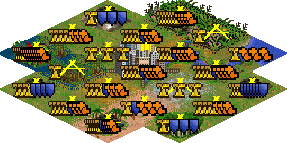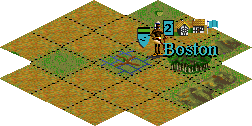Scrolls of Ancient Wisdom
Sections:
- Airbase Magic
- Irrigation Anywhere
- Settler Speedup
- Trade-offs
- Bribery
- Spaceship Shuffle
- Demographics
- Time Warp
Foreword: Sid Meier’s CivilizationII is one of the greatest computer games of all times. It is seriously addictive and has kept me from getting enough sleep many a night. Here I compiled some little-known facts I have found neither in the handbook nor in online strategy guides so far, but which were mentioned on the alt.games.civ2 newsgroup, and some I discovered all by myself.
Airbase Magic
 This is one of the neatest tricks in CivilizationII. If you build an airbase, it counts as farmland and railroad in all respects: two additional food tokens if you have a supermarket in the city, no movement cost, road/railroad trade benefits, and an additional shield where applicable! This works on most terrain types, but it is particularly useful on squares which you would not or could not normally irrigate, e.g. hills or mountains, as you can combine the effects of irrigation/farmland and mining. In the example on the right (the city has a supermarket and superhighways), only airbases were used, and four squares were mined (mountain, hill, coal, oasis), but no irrigation, farmland, roads or raildroads were built.
This is one of the neatest tricks in CivilizationII. If you build an airbase, it counts as farmland and railroad in all respects: two additional food tokens if you have a supermarket in the city, no movement cost, road/railroad trade benefits, and an additional shield where applicable! This works on most terrain types, but it is particularly useful on squares which you would not or could not normally irrigate, e.g. hills or mountains, as you can combine the effects of irrigation/farmland and mining. In the example on the right (the city has a supermarket and superhighways), only airbases were used, and four squares were mined (mountain, hill, coal, oasis), but no irrigation, farmland, roads or raildroads were built.
| Terrain | Typical | Instead | Adds |
|---|---|---|---|
| Hill | M+RR | M+A | +2F |
| Mountain | M+RR | M+A | +1F |
| Desert | M+RR | M+A | +1F |
| Oasis (Desert) | II+RR | M+A | +2S |
| Fruit (Jungle) | RR | A | +2F |
| Spice (Jungle) | RR | A | +1F |
| M: Mine, II: Farmland, RR: Railroad, A: Airbase, F:Food, S: Shields | |||
As you can see from the table above, on certain types of terrain airbases add even more food production compared to what would be possible otherwise following normal procedure (the figures assume a supermarket in the city). Airbases also work together well with special squares on these terrain types such as coal, wine, iron, gold, and oil (desert). Unfortunately, they do not have similar beneficial effects on swamp, jungle, or glacier. An interesting side effect of surrounding a city with several airbases is that attacking enemy air units will have a hard time finding a way in. Make sure your own planes don’t get stuck in the airbase labyrinth, though!
A few concluding remarks: it is not possible to build an airbase and a fortress on the same square, and Despotism restrictions (no more than two tokens of any kind) apply to airbases also.
Irrigation Anywhere
 This is a very handy settler cheat. Remember those grassland squares for which you would have to transform three mountains in order to get them irrigated? The automated settler can do it much quicker. Press "k" or choose "Automate Settler" from the "Orders" menu, and the settler will first build a road and then irrigate the square, even if there’s no water around! However, I have found that this does not work reliably in all circumstances. In particular, it only seems to work as long as the nearby squares don’t have too many improvements, otherwise the settler gets confused and wanders off immediately. From my experience it’s safest to start with the pesky square right away.
This is a very handy settler cheat. Remember those grassland squares for which you would have to transform three mountains in order to get them irrigated? The automated settler can do it much quicker. Press "k" or choose "Automate Settler" from the "Orders" menu, and the settler will first build a road and then irrigate the square, even if there’s no water around! However, I have found that this does not work reliably in all circumstances. In particular, it only seems to work as long as the nearby squares don’t have too many improvements, otherwise the settler gets confused and wanders off immediately. From my experience it’s safest to start with the pesky square right away.
Settler Speedup
If you are in a hurry improving a particular square, you can interrupt a Settler or Engineer that has already been working (but not yet finished) on another piece of land for a while and move him to that square – the number of turns he has already worked are stored and will now be added to the new task. Of course, you can also stack any number of these units to work simultaneously to really speed up terrain improvements.
Trade-offs
The amount of trade and the bonus payment you get for establishing a trade route between two cities with a caravan or a freight depends on quite a few factors. The formulas below contain all the details; they are based on an alt.games.civ2 post by Robert Lancaster:
Trade = ( trade of home city + trade of destination city + 4 ) / 8
Note that it does not directly depend on city size or distance. The following (cumulative) modifiers apply:
| Both cities are yours | -50% |
| Freight instead of caravan | +50% |
| Cities connected by road | +50% |
| Cities connected by rail | +50% |
| Cities on different continents | +100% |
| Airports in both cities | +50% |
| Superhighways in home city | +50% |
The one time bonus payment is calculated as follows:
Payment = ( ( distance + 10 ) x ( trade of both cities ) ) / 24
It increases if the destination city demands one of these goods (double these figures if the city is not yours):
| Silver, Cloth, Wine, Coal | +50% |
| Silk, Spice, Gems, Gold | +100% |
| Oil | +150% |
| Uranium | +200% |
The final bonus payment figure is then doubled during the first 200 game turns or until either Navigation or Invention are discovered. It is reduced by one third after the discovery of Railroad, and by another third after the discovery of Flight.
Bribery
The cost for bribing an enemy city depends on a number of factors. The formula below contains all the details; it is taken from an alt.games.civ2 post by Danil Proost:
Cost = ( ( enemy gold + 1000 ) / ( distance + 3 ) ) x citysize
I am not sure which distance is meant in this formula. It is probably the distance between the city and its capital. However, the cost depends on the square your Diplomat or Spy bribes from. It often pays to try to bribe from different squares – I have observed the cost vary by as much as 20%. At any rate, the distance is also influenced by the following factors:
| Courthouse in city | half distance |
| Enemy government is Communism | max. distance is 10 |
| Enemy has no palace | distance = 32 |
The following (cumulative) modifiers apply to the cost for bribing:
| City in disorder | -50% |
| No units in city | -50% |
| City was yours before | -50% |
| Spy is bribing | -16% |
| Veteran unit is bribing | -33% |
Spaceship Shuffle
Have you ever been producing your spaceship and wondered if you needed to build any more structurals, or how many propulsion units would be enough? This little table below summarizes these data for a spaceship with one habitation unit, one solar panel and one life support.
| Components | Structurals | Years |
|---|---|---|
| 6 | 15 | 15.7 |
| 8 | 17 | 13.2 |
| 10 | 21 | 10.0 |
| 12 | 25 | 8.3 |
| 14 | 29 | 6.7 |
| 16 | 33 | 5.7 |
The number of components given always comprises an equal number of propulsion and fuel units (i.e. 8 components means 4 of each). The number of years in the table already includes the 25% boost from the discovery of fusion power.
Demographics
The following table is based on alt.games.civ2 posts by Robert Lancaster and Jeffery S. Jones.
| Approval Rating | % | Ratio of happy to unhappy people |
| Population | ||
| GNP | million $ | Based on trade and tax/luxury rates |
| Manufactured goods | Mtons | Total number of shields (including unit support) |
| Land Area | sq. miles | Number of squares that your units have been the last to move through |
| Literacy | % | Based on number of Libraries, Universities, Research Labs; discovery of Writing, Literacy; science rate |
| Disease | % | Based on number of Aqueducts, Sewer Systems; discovery of Medicine, Sanitation |
| Pollution | tons | Total number of "smoke stacks" times 10 |
| Life Expectancy | years | |
| Family size | children | Based on average food surplus |
| Military Service | years | Number of military units in relation to population |
| Annual Income | $ per capita | |
| Productivity | Shields (minus support) per square in use (?) |
Time Warp
The number of years that pass each turn depends on the difficulty level: playing the easier levels gives you more turns to finish the game. The tables below contain all the details (this information is based on an alt.games.civ2 post by Jon Nunn; I have only partially confirmed the figures). Note that as soon as a spaceship is launched, the game will automatically switch to one-year turns.
| Years/Turn | Chieftain | Warlord | Prince | King | Emperor | Deity | |
|---|---|---|---|---|---|---|---|
| 4000BC-2000BC | 20 | 40 | 50 | 50 | |||
| 2000BC-1000BC | 20 | ||||||
| 1000BC-0001AD | 25 | 25 | |||||
| 0001AD-1000AD | 20 | 20 | |||||
| 1000AD-1500AD | 10 | 10 | 10 | ||||
| 1500AD-1750AD | 5 | 5 | 5 | 10 | |||
| 1750AD-1850AD | 2 | 2 | 2 | 2 | |||
| 1850AD- | 1 | 1 | 1 | 1 | |||
| Total Turns | Chieftain | Warlord | Prince | King | Emperor | Deity | |
|---|---|---|---|---|---|---|---|
| until 2000BC | 100 | 50 | 40 | 40 | |||
| until 1000BC | 150 | 100 | 60 | 60 | |||
| until 1AD | 200 | 150 | 100 | 100 | |||
| until 1000AD | 250 | 200 | 150 | 150 | |||
| until 1500AD | 300 | 250 | 200 | 175 | |||
| until 1750AD | 350 | 300 | 250 | 200 | |||
| until 1850AD | 400 | 350 | 300 | 250 | |||
| until 1900AD | 450 | 400 | 350 | 300 | |||
| until 1950AD | 500 | 450 | 400 | 350 | |||
| until 2000AD | 550 | 500 | 450 | 400 | |||
~ End of Scroll ~
